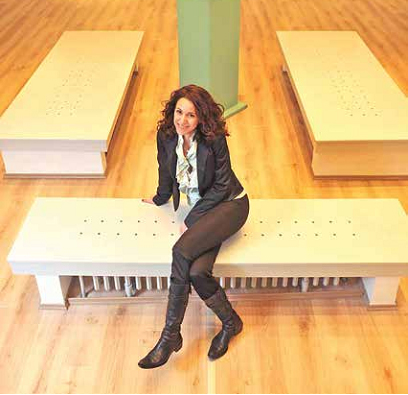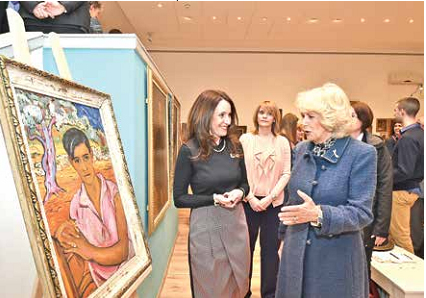By: Teodora Ž. Janković
The Gallery of Matica Srpska (GMS) was this year one of the nominated candidates for the prestigious European Museum of the Year 2016 and presented itself in Tolosa and San Sebastian, with a repeat in April from Spain – Acknowledgement for worthy achievements in raising the quality of the museum which was brought to the building in Novi Sad’s Square of the Gallery by administrator Tijana Palkovljević-Bugarski
Hailed as one of the most successful female managers in culture in Serbia, this art historian since 2010 has worked – together with her team of curators, conservators, art historians and other professionals – to achieve results that have been also been noticed in EU Member States.
In times that are challenging for all segments of the impoverished Serbian society, crisis in the field of culture is seen through very small budget allocations, but you have found it easy to present the Gallery of Matica Srpska not only in Spain, but also in the “heart” of the EU – in Brussels, with an exhibition of Serbian cultural heritage, followed by an exhibition at the National gallery in Perugia, while you also have plans to present in Japan in the year ahead?
— You’re right, though we are still in the planning phase, my colleague and fellow art historian, Michitaku Suzuki, who deals with Slavic cultures and who has a desire to present Serbian icon painting in Japan, is considering with us the possibility of achieving a representative exhibition in Tokyo and another Japanese city in 2017, because he was delighted with the way we presented our heritage in Umbria, where we toured in 2015 with excellent iconographic painters from the 18th century in Perugia. We followed the idea of cultural policy last convened by the Ministry of Culture of the Republic of Serbia, which was to raise the level of institutions. This was a shift in relation to the Brussels exhibition activity, in which we presented Serbian culture at the Hungarian Cultural Institute in Brussels. In the case of Italy, this level of cooperation was raised at the interstate level, thanks precisely to the two national galleries.
You took over the position ofadministrator of the national gallery in 2010, advancing from the function of assistant administrator, which you held from 2003. You are “in the material” of the life of the Gallery of Matica Srpska, through the decades of your professional journey, and you can probably objectively overview what was found and what was done in the last decade?
— I inherited good organisation and had the great fortune to have the opportunity to collaborate extremely closely with the previous administrator, Branka Kulić. I also had the necessary support from her, with the kind of dose of freedom that is so essential to young people, who by nature want to change things, because this institution, which is traditional and conservative in a positive way, always had great resources, which did not correspond to the time in which it exists. The fact that we inherited the entire Serbian fine art collective from the 16th to the 21st century was an opportunity to tell the story of our people through history and art, which as a visual medium that corresponds with the audience better than any text. It was only necessary to adjust the guided tour through the permanent exhibition of contemporary times. In this sense, through our work we earned the title of the best museum in South-East Europe.
You totally redesigned and re-conceptualised the Gallery of Matica Srpska, respecting the founding postulate as a national gallery, while democratising it in modern times.
— Our job is, other things, researching Serbian art. My predecessors have since 1958, when we moved into this building, done a crucial job in terms of auditing works of art, Reconnaissance terrain outside the gallery; we published key monographic and essayistic editions. But during the ‘90s that whole process was in terrupted and slowed own, and the whole world rapidly changed in socio-political terms, but also in an aesthetic sense, and this is what we tried to adapt to. My predecessors left a respect for everything done in the last century by our founders and benefactors, and then we succes sively approached changes piece by piece. Since then we have managed to form our club of friends, to take strides in terms of marketing and PR, thereby rebranding our art gallery in the most modern way. We became activated in the European Committee of ICOM (the global organisation of museums), because I became a member of the committee responsible for the education and training of museum staff, adhering to the notion of the permanent training of employees in the institutions of culture, just as important as, say, a doctor (laughs).
We also changed the concept of the exhibitions, turning more towards the public, introducing educational programmes for children and looking to open a gallery space for the widest possible audience.
We used the practice sand postulates of modern museology, the so-called “2.0” principle, which implies that museums cease to be only places of academicism and elitism, becoming a meeting point and place of education and tourism for the widest possible audience. We also carried out changes in the physical sense, reconstructing the building itself, because our building remained unaltered since 1926. We arranged the basement area, which amazingly improved exhibit storage conditions and conservation work in the workshop. We reconstructed studios and offices, and the gallery hall itself. Our entire focus in recent months has been around the façade (which was last painted more than 40 years ago), and that will be the finishing touch, planned for the anniversary of 170 years of its existence in 2017, with the desire to make the exterior shine with the same kind of shine with which we glow from within. I am extremely proud of all of our achievements to date and the result and impression from the community itself adds value to this endeavour of ours.
TARKETT & GMS
As part of its programme activities, presenting itself through the recently completed event “Museums for ten days from 10 to 10”, the Gallery of Matica Srpska again took a step forward in terms of its work and operations, with the opening of the exhibition “From private towards public”, which presents the art collection of company Tarkett, with which the Gallery of Matica Srpska began cooperation a decade ago with an audit and conservation and restoration of its collection, which is an example of a successful public-business partnership in the protection and presentation of national cultural heritage, with the intention of the company donating this valuable art collection to the Gallery of Matica Srpska. This exhibition also raised the question of how to find legal solutions and methods to make national art treasures owned by private social companies available to the general public:
– By transferring works of art from the private sphere to the public sphere through their presentations, publishing in the catalogue and communication with the public, we provide them with longevity. I believe that in the period ahead of us we will realise the intention of company Tarkett to donate its permanent art collection to the gallery of Matica Srpska and thereby enrol itself in our list of institutional sponsors. This generous gesture would also continue the tradition of transforming institutional collections into public ones, which would hopefully encourage other com panies to do something similar.
As we complete this article, information is arriving that Vojvođanska Banka, which also possesses a valuable collection of several hundred works of art from the late 20th century, has asked the Gallery of Matica Srpska to process its collection, and an exhibition showcasing its most representative works is planned for this autumn. It remains to be seen whether this collection will also enter the sphere of philanthropic donations and socially responsible operations in the field of relations towards cultural treasures. It is certain, however, that in the near future this company will join the Club of Friends of the Gallery of Matica Srpska and contribute to the project of reconstruction of the façade.
BRITISH ROYAL VISIT
As part of their tour of the Western Balkans, Serbia and Novi Sad, you were visited by the Prince of Wales and the Duchess of Cornwall, who were presented with the Gallery of Matica Srpska, which attracted a lot of attention among the international and the domestic public. Here the museum’s administrator talks about her impressions of the British royal couple:
This was our first royal visit, though in the previous period we have had many influential and important guests, and our impressions are wonderful. It was a challenge for us to present our institution and to show as much as possible in a short period of time, because they came to see the programme we are implementing in cooperation with the British Council, under the title “Moving museums”, which is aimed at involving the young people of Southeast Europe in the work cultural institutions, i.e. museums. They wanted to see how this programme, which they finance, functions. Of course, this was also an opportunity to show them works of Serbian culture from the 18th and 20th centuries. We also presented the workshops we do with children, where some programmes are related to the English language and culture. I took the opportunity to introduce Prince Charles to the oldest icon of our collection, the icon of the Annunciation, made in the spirit of the post-Byzantine tradition, which is the point from which the development of our national art of modern times started. Through the story of this icon, I spoke about what happened to Serbian art from the Middle Ages, when it was at a high level, to the new era, when it again began to develop after the Serbs relocated to the area to the north of the rivers Sava and Danube. I showed him graphics prints from that journey, primarily the graphics of Hilandar monastery (Charles is a major benefactor and visitor to Hilandar), which particularly fascinated him, since he has been there and I have not. My theoretical knowledge and his practical knowledge coincided, and as he was in a delegation as the president of the Foundation of Friends of Hilandar, we managed to have a nice conversation will standing over a nice graphic showing Mount Athos and its monasteries in their entirety. Charles was also very interested in the way in which we take care of our cultural heritage in conservation and restoration processes, and he was intrigued by the portrait of our founder, Sava Tekelija, and the history related to the institution itself.

